Yoga for back pain-
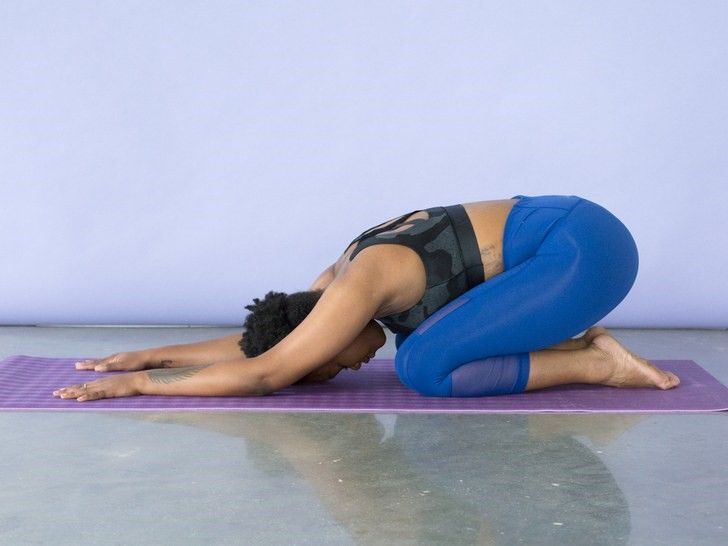
8. Poses of Yoga for back pain
“Yoga is great for working on flexibility and core stability, correcting posture, and breathing—all of which are necessary for a healthy back,” Sasha Cyrelson, P.T., D.P.T., O.C.S., clinical director at Professional Physical Therapy in Sicklerville, New Jersey, tells SELF. She adds that daily yoga practice is safe. It’s important, though, to make sure you’re in tune with your body and stop doing anything that makes your discomfort worse. “Never stretch into a position of pain. Pain is how our bodies tell us something is wrong. “If it actually hurts, eases up on the stretch.”
If you have any history of lower back injuries, problems with your discs, or experience pain that lasts more than 72 hours without improving, Cyrelson suggests seeing a physical therapist before doing any exercises. If you have an issue that requires medical attention, it’s best to address it before it becomes worse.
If your lower back pain is more of a general achiness or discomfort, it’s worth trying some yoga stretches to address any tightness and alignment issues. We asked Shanna Tyler, a yoga teacher in New York City, to tell us about and show us some of her favorite yoga stretches for relieving lower back pain. She recommends doing the stretches below as a flow, holding each pose for anywhere from one to three minutes. “As long as it feels good, then do it all,” she says.
Here are the stretches she recommends:
- Child’s Pose
- Cat/Cow
- Standing Forward Bend
- Downward Facing Dog
- Sphinx Pose
- Knees to Chest With Slow Rock
- Reclined Pigeon Pose
- Reclined Supine Twi
Child’s Pose — 1 to 3 minutes
“Child’s Pose takes the pressure off your lower back by elongating and aligning the spine, which decompresses it and gives you a nice stretch,” Tyler says.

– Kneel on your mat with your knees hip-width apart and your feet together behind you. Take a deep breath in, and as you exhale, lay your torso over your thighs.
– Try to lengthen your neck and spine by drawing your ribs away from your tailbone and the crown of your head away from your shoulders.
– Rest your forehead on the ground, with your arms extended out in front of you.
– Hold for one to three minutes.
Read Also
Physical Activity for -A Healthy Lifestyle
Cat/Cow — 1 to 3 minutes
“This is probably my personal favorite stretch for my back,” Tyler says. It allows for a nice flexion and extension of the spine, promotes mobility, and “it also helps to just relieve any tension in the lower back.” Cat/Cow also helps you get familiar with what your neutral spine is—not too arched and not too rounded—which can help improve posture.
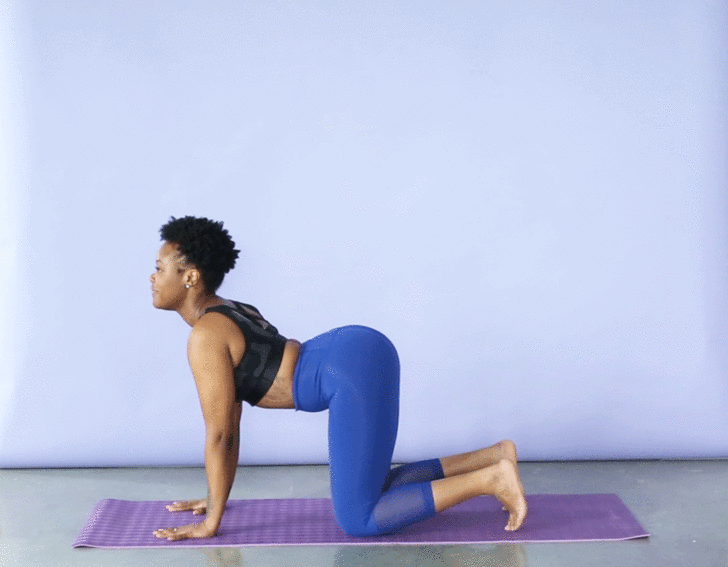
– Start on all fours with your shoulders over your wrists and hips over your knees.
– Take a slow to inhale, and on the exhale, round your spine and drop your head toward the floor (this is the “cat” posture).
– Inhale and lift your head, chest, and tailbone toward the ceiling as you arch your back for “cow.”
– Do this for one to three minutes.
Downward Facing Dog — 1 to 3 minutes
“Sometimes, we feel lower back pains because the backs of our legs are so tight,” Tyler explains. Down Dog is a great way to stretch out your hamstrings and calves. If you’re extra tight, you can bend your knees a little bit to make the stretch more comfortable.
–
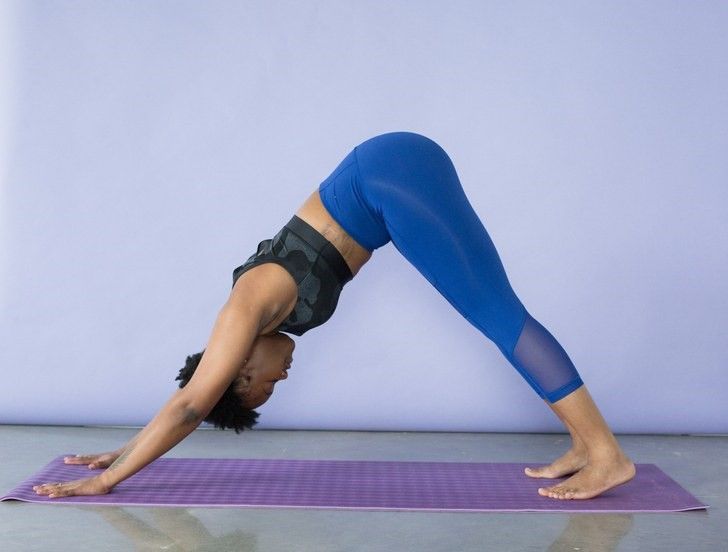
From Child’s Pose, keep your hands on the floor, sit up on your knees, and then lift your butt and press back into Downward Facing Dog.
– Spread your fingers wide. Work on straightening your legs and lowering your heels toward the ground.
– Relax your head between your arms, and direct your gaze through your legs or up toward your belly button.
– Hold for one to three minutes.
Standing Forward Bend
This stretch also stretches out the backs of the legs and lengthens the spine, both of which relieve the lower back. Modify by keeping the knees slightly bent if straightening your legs hurts your back, Tyler suggests.
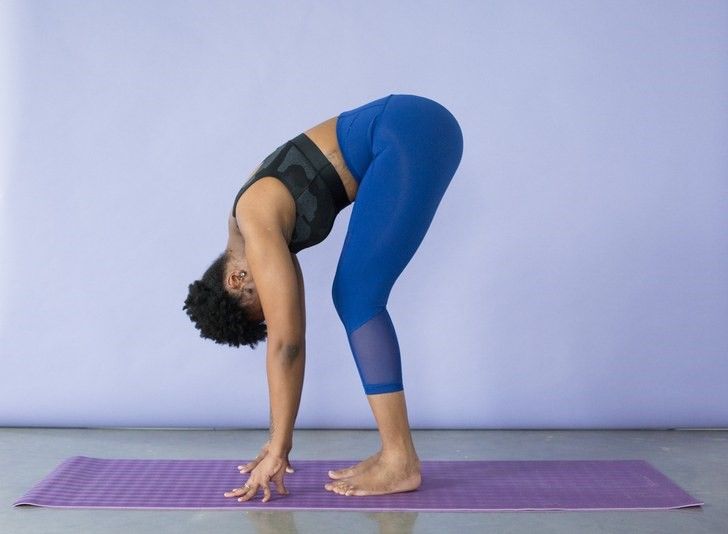
– From Downward Facing Dog, slowly step forward to the top of your mat. Stand with your feet shoulder-width apart.
– Straighten your legs out as much as you can and let your torso hang down.
– Tuck your chin in toward your chest, relax your shoulders, and extend the crown of your head toward the floor to create a long spine.
– Hold for one to three minutes.
Pro tip from Cyrelson: “Try thinking about keeping your butt sticking out during this move so that the bend comes from your hips, not your back.”
Sphinx Pose — 1 to 3 minutes
“Sphinx pose creates a nice natural curve of the lower back,” Tyler says. It also engages your abs a bit, which is helpful for supporting the lower back.
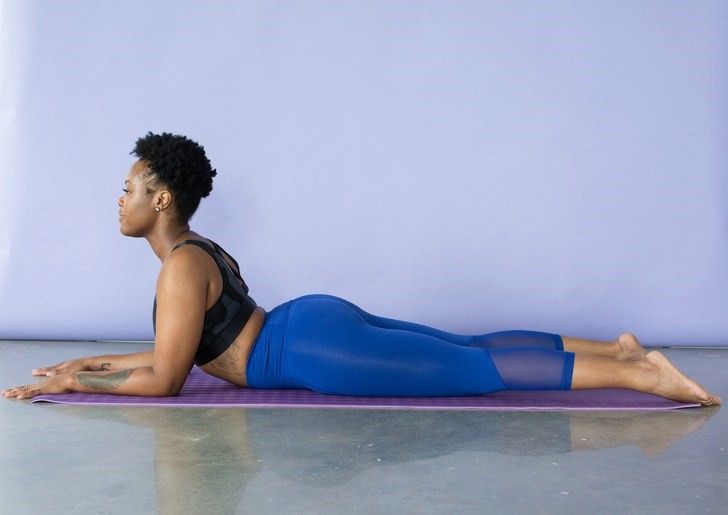
– Lie on your stomach, legs together and straight out behind you.
– Place your elbows under your shoulders and your forearms on the floor as you lift your chest up off the floor.
– Press your hips and thighs into the floor, and think about lengthening your spine while keeping your shoulders relaxed.
– Sit up just enough to feel a nice stretch in your lower back. Don’t hyperextend, and stop immediately if you start to feel any discomfort or pain.
– Hold this position for one to three minutes.
Carlson suggests tucking your tailbone under and pulling your belly button in toward your spine to minimize any hyperextension of the back.
Knees to Chest With Slow Rock — 1 to 3 minutes
Tyler says that she likes to add a slow rocking motion to this basic stretch because it “gives you a nice, natural body weight massage.”
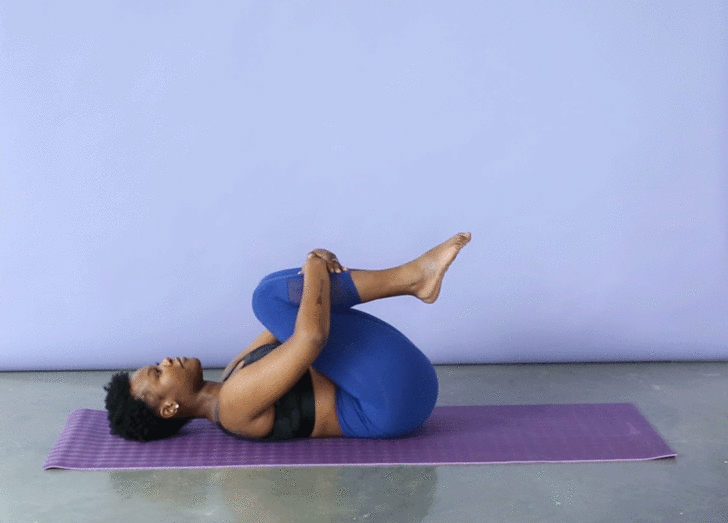
– Lie on your back.
– Hug both knees into your chest.
– Slowly rock your torso back and forth while firmly holding onto your legs.
– Do this for one to three minutes.
-
Reclined Pigeon Pose — 1 to 3 minutes, each leg
This move, also known as “figure-four,” stretches the hips, butt, and inner thighs, Tyler says.
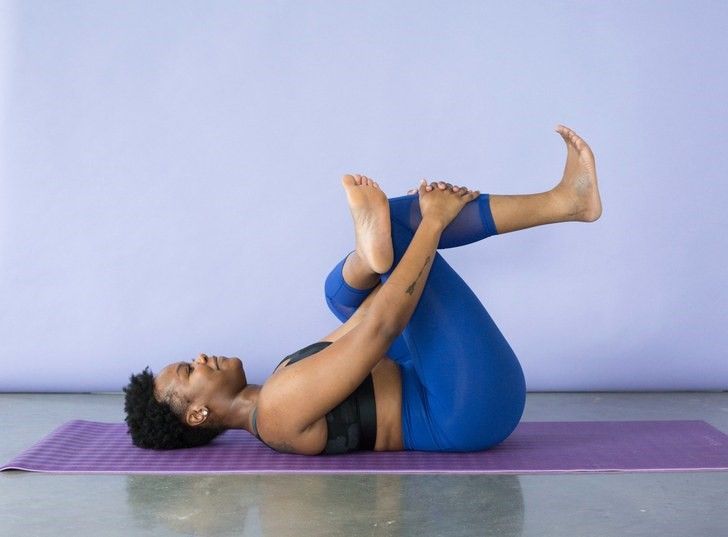
– Lie on your back.
– Cross your left foot over your right quad, and bend your right knee.
– Hold the back of your right leg and gently pull it toward your chest.
– When you feel a comfortable stretch, hold it there for one to three minutes.
-Switch sides and repeat.
-
Reclined Supine Twist — 1 to 3 minutes
Tyler says that this is a great stretch for the lower back, and can provide some pain relief if you’re tight. For some people, though, twisting movements can irritate the lower back. If this stretch starts to hurt, stop doing it. You can also try putting a towel underneath your knees to help you ease into it if you’re super tight, she says.
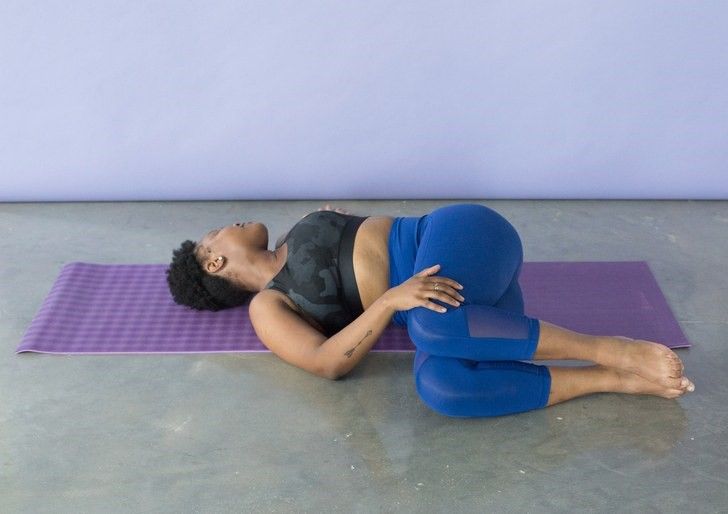
– Lie on your back.
– Hug your knees into your chest. Then, drop both knees over to one side as you twist your torso in the opposite direction.
– Try to keep your knees and hips in line with each other as you draw them toward the floor, and keep your chest as square to the ceiling as you can.
– Hold this stretch for one to three minutes, and then repeat on the other side.



